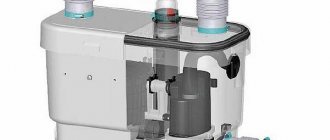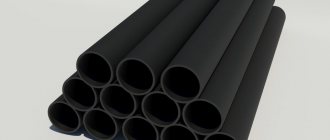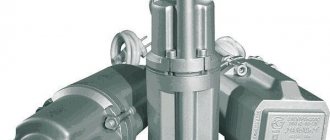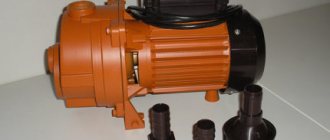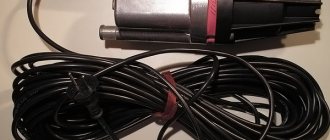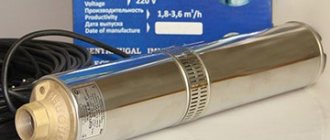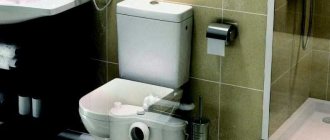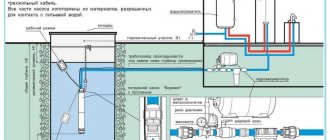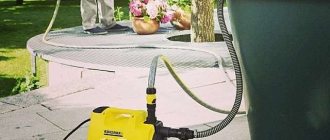Manufacturers and models
Not many companies produce individual sewerage installations. However, the price range is quite wide. Traditionally, European manufacturers are distinguished by good quality, but high prices. No one will be surprised if we say that Chinese sewage pumps cost less, but their quality is worse. In general, the choice, as usual, is expensive and high quality, or cheaper and...
Forced sewerage installations Grundfos (Grundfos) - Sololift (Sololift)
The well-known manufacturer of plumbing fixtures Grundfos produces Sololift pumps for forced sewerage. At the moment, a modified Sololift2 line has been launched. There are no moving parts in contact with drains. The exception is the chopper, but its drive is also “dry”. This makes repairs less of a hassle. There are several Sololift models for different cases:
Sololift sewer pumps are not the cheapest equipment, but they work reliably and meet the stated characteristics. The company also supports warranty repairs.
Pumps for toilets, bathrooms, kitchens and technical rooms SFA
This company specializes in the production of sanitary pumps. There are several lines to solve different problems and connect various devices:
SFA products work reliably and cost slightly less than Grundfus. You can choose a model for any combination of plumbing fixtures. Overall, the SFA sewage pump is a good option. Equipment installation is standard - place it in any convenient place. There is only one limitation - it is better for the outlet pipeline to start from a vertical section, if there is one on your route. If this is not possible, the length of the horizontal section should be no more than 30 cm.
The height of the vertical section is calculated taking into account that the horizontal section must have a slope towards the inlet of at least 1% (1 cm per 1 meter of pipe).
CompactLift fecal pumps from Aquatik
Toilet pumps Compact Lift are produced by the Chinese company Aquatic. This is a more budget-friendly option for individual sewer installations. They have a low noise level.
At the moment there are only three modifications:
Aquatik provides a warranty on its pumps for bathrooms and toilets for 1 year from the date of sale. Failure to operate (presence of fibrous inclusions in drains) may result in refusal of warranty repair.
Willo sewage pumps
The German company Willo is known for producing reliable devices. Toilet pumps are no exception. Good quality plastic, thick tank walls, reliable pump. The following models are available:
The Willo range of sewer pumping units allows you to solve any problem when it comes to equipping bathrooms and toilet rooms in private homes. For commercial or more intensive use, Willo has other solutions.
Pressure sewage pumps STP (Jemix)
These custom sewer installations are manufactured in China. The price category is average. Reviews, as usual, are different - some are completely satisfied, others categorically dislike it.
So, here are the sewerage pumps Jemix offers:
It differs from those described above in its increased power - some models raise drains by 9 meters. Most of the sewerage pressure pumps described above can lift wastewater up to 4-5 meters. So this is where the Jamicks win. In this parameter they have only one competitor - Sololift Grundfos with its lifting height of 8 meters. But its price category is completely different (as is its quality, for that matter).
type of instalation
- General purpose. Such models are connected to several household and plumbing fixtures, and therefore are mainly installed in private residential buildings. They can be considered universal, since they are distinguished by increased pump power and the values of a number of other parameters.
- Individual use (special purpose). These sewer installations are simpler, and their capabilities are somewhat limited. They are focused on “servicing” only one reset point. In other words, they are connected only to a specific product (shower stall, toilet, dishwasher, etc.). If it is necessary to organize forced drainage of wastewater from all household appliances in the house connected to the system, for each one you will have to purchase a separate CCS of this group.
Device and purpose
A pump with a grinder is a surface sewer pumping installation that allows you to organize the removal of wastewater where it is not possible to do this using a gravity system. This is a small plastic container with a powerful built-in pump that pumps waste into the sewer. The movement of drains can be both vertical and horizontal. There are installations with a grinder that can be connected to toilets, and there are those without a grinder - for “gray” waste from sinks, showers, bidets, etc.
Application area
A sewer pump is used in cases where it is impossible to create a gravity sewer system. In most cases, when a plumbing fixture, washing machine or dishwasher is installed below the entrance to the sewer. This is why forced sewage pumps were invented. This solution allows you to move bathrooms and technical rooms to basements or semi-basements.
A pump with a grinder is also installed if it is decided to build a bathroom after the renovation is completed and the sewerage system is not connected to the place where the plumbing is supposed to be installed. In this case, the installed equipment is connected to a compact sewage pump, and it is connected to the sewer. What is the difference? In the following:
- the diameter of the outlet pipes for the sewer pump is much smaller than for the gravity system (28-40 mm);
- drains can rise up to a height of up to 9 meters;
- horizontal wastewater disposal is possible up to 100 meters (requires a minimum slope of 1-4%).
All this allows you to organize a connection to an existing sewer system almost anywhere at minimal cost.
Design and principle of operation
The sewage pump consists of a plastic storage container and a pump. Some models that can be connected to a toilet have a grinder. The filling level is controlled by a sensor. When it is triggered, the grinder and pump are turned on, and wastewater is pumped into the sewer system. The shutdown is controlled by a second sensor - it turns off the power when the wastewater level drops below a certain level. This is a simplified algorithm for the operation of pressure sewerage.
There are sewage pumping stations designed to connect devices of various types and quantities. The simplest one is designed to connect one or two devices, the most productive one has three additional pipes (and one main one). Accordingly, the container has one or more inlet holes (depending on the model) and one outlet hole. Pipes coming from the plumbing are connected to the inlets, and the outlet is connected to the sewer.
For pumping out high-temperature wastewater from washing machines, dishwashers, and bathtubs, there are special models made of heat-resistant materials. A conventional sewage pump cannot cope with such a load. Therefore, to connect such equipment you need to look for certain models.
Use of forced sewerage
Features of drainage of dishwashers and washing machines
Everyone knows that modern automatic machines (washing or dishwashing) must be connected to the sewer system in order to remove contaminated used water. But in small city apartments there is hardly room to install these assistants in the sewerage area; this is typical for both the bathroom and the kitchen.
And in large cottages, you want to hide the units in the basement rooms, which often serve as the utility floor. In both cases, there is a solution if forced sewage pumps are used. The essence of the solution is as follows:
- Here you will need to place a special sewerage installation equipped with a water collection tank and a built-in pump.
- The drains gradually fill the container in which the float switch operates. When their volume reaches a certain value, a pump is turned on, pumping contaminated water into the sewer.
- Such forced sewerage is small in size and is installed in an apartment or house in close proximity to the equipment that produces wastewater.
- It is equipped with a carbon filter that prevents unpleasant sewage odors from entering the room.
A reliable and efficient system does not require specific maintenance measures; you only need to periodically clean and rinse the tank.
Reconstruction or relocation of a bathroom
As mentioned above, moving a bathroom to another, more convenient place can be done in two ways:
- carry out redevelopment of the apartment, carrying out a major overhaul of the premises;
- install forced pumps for pressure sewerage.
The second option is more affordable and faster. But at the same time, you need to purchase a sanitary pump that meets special requirements. After all, he will have to work with aggressive environments.
Types of pumps for summer showers
In fact, any pump that is sold in stores today can be used to fill a shower tank. But in this huge assortment there are also units that are used only for showering. And some of them are not designed to fill a water tank, but to directly pump water into a hose connected to a watering can.
Battery powered shower pump Source guide.alibaba.com
The first pump that can be classified in this category is a small device operating from a 12-volt network. This is a small-sized pump, the package includes a small-sized hose with an umbrella (aka watering can) and an electrical cable with an adapter. The latter converts the voltage from a 220 V outlet to a voltage of 12 V. The package also includes a special pin adapter that allows you to connect the pumping device to the car via the cigarette lighter. Let us add that there are pumps of this type on the market that operate on conventional batteries.
It should be noted that in dacha conditions this is a good option. This pump is compact, consumes little electricity, and has good pressure - up to 1.5 m. Performance varies depending on the chosen model, where the maximum is 16 l/min. Let us add that the pump kit includes a submersible pump. That is, to supply water to the umbrella (watering can), you need some kind of reservoir where the water is accumulated. It could be a barrel, a well, a lake, etc.
Shower pump with adapter and finger adapter Source www.pinterest.ru
Such country pumps have a standard hose length of 2 to 3 m, and an electric cable length of 5 m. In principle, the dimensions are acceptable for organizing a shower. The main task of the user is not to wet the power cable. And although many manufacturers make it electrically protected, there is no point in taking risks. The only disadvantage of this pump is its energy dependence. If the electricity supply is turned off at the dacha, then this device, of course, will not work.
The second pump for a summer shower in the country is called “Toptun”. This device got its name because to supply water to the watering can, you have to press the pumping device with both feet. Therefore, the unit includes:
- special rubber mat , which is divided into two sealed cavities connected by a passage;
- water supply hose to the pump , its manufacturers call it a water intake hose;
- a water-receiving hose on which a nozzle is installed, also known as a watering can.
The operating principle of this installation is very simple:
- the water intake hose is lowered into a container of water;
- the water-receiving device is hung at the required height;
- feet alternately press on the cavities , creating a vacuum inside, under the influence of which water begins to be sucked into the pump;
- water from one cavity flows into another and is supplied to a hose with a nozzle .
Pump for a summer shower “Toptun” Source stroychik.ru
The more intensely a person works with his legs, the greater the pressure and performance of the device. Let's add that the legs work, and the hands remain free, which makes it possible to use them for washing the body. The most interesting thing is that such a shower can be organized with warm water. It is preheated and poured into a container, from where the liquid enters the pumping unit. And although the device is mainly made of rubber, it can easily withstand very warm water – up to +65C.
Today, manufacturers offer another variety of “Toptuna”, which has an addition to the name – “mini”. It differs from the classics only in that the rubber mat contains not two cavities, but one. The operating principle of such a device is practically no different from the standard one. It simply uses the laws of physics when pressure is created inside the channels due to either a sharp increase or a sharp decrease. About half the price of the standard model.
The Toptun-Mini pump is the smallest unit for a summer shower Source tech-domain.com
I would like to add that “Toptun” is not necessarily a rubber mat, although the original model was just that. Today, manufacturers offer other designs that work on the same principle. For example, the photo below shows a pump that has two cylinders. By pressing your feet alternately on each of them, the pump works exactly the same as a traditional model. The cylinders are simply connected to each other by a tube.
Toptun-Step pump with cylinders Source ufa.bestprice.su
In general, today summer residents pay special attention to mini pumps for summer showers in the country. The thing is that these are universal devices. With their help, you can not only take water procedures, but also wash your car, bathe pets, water flowers, etc. It is the versatility of these units that captivates, plus, of course, the low price of the product.
Types of forced fecal pumps
- Equipment for pumping gray wastewater at high temperatures without including fecal waste. In this case, the pump does not have a grinder and is capable of transporting hot, more or less clean water from a washing machine or dishwasher, as well as from a kitchen sink. The dimensions of the installation are quite compact, which allows you to mount the sololift directly in the kitchen cabinet under the sink or even on the wall. The pump works with water whose temperature does not exceed 90 degrees. Such equipment is relevant for installation if the kitchen or laundry room is located far from the central riser.
- Model of a pump for hot wastewater with a grinder. This device is designed for pumping wastewater, the temperature of which can reach 95 degrees. Thanks to the powerful knife built into the mechanism, the sololift processes all fecal and hygienic waste, including small items. Thus, the installation of such a forced sewage system is relevant in almost any of the plumbing or utility rooms of a private house or apartment. But the cost of such a sololift is several times higher than that of the previous model.
- Pump with grinder for cold drains in the house. Most often, this unit is used for installation behind the toilet. The shredder's sharp blades do an excellent job of removing any fecal waste. Thus, the equipment can operate uninterruptedly, provided that the temperature of the wastewater does not exceed 40 degrees. Included with this pump is a special coupling for a high-quality connection of the forced sewage system with the toilet.
Types of pumping equipment for the kitchen
There are several types of devices, depending on the tasks performed. All models pump out wastewater, but in different cases it is more effective to use different types of equipment. They are divided into the following types:
- sanitary;
- stationary;
- pumping stations.
Sanitary models are considered the easiest to install; they have low power and in most cases are mounted under the sink. As a rule, they do not have chopping knives in their design. The temperature of the waste liquid cannot exceed 40 degrees; such models are capable of draining wastewater from only one unit of plumbing fixtures.
Connecting a washing machine and dishwasher will not work. The advantage of this type is its small size, ease of installation and dismantling, and low energy consumption. Such a sewage pump is often installed in small apartments.
The stationary version in most cases is connected to several devices at once and is installed away from all plumbing. Such devices are suitable for treating hot water (up to 75 degrees) and have greater power. As a rule, they are equipped with grinding elements.
Domestic sewerage stations have the greatest capacity. The maximum vertical movement is approximately 10 meters, horizontal movement can reach 100 m. Such models are rarely installed in apartments, most often they are installed in country dachas and cottages. Adapted to high water temperatures, can work continuously for a long time.
Design and principle of operation of forced sewerage
To understand how the drainage forcing system works, you need to know its structure. Thus, the forced sewage system consists of a capacious tank, inside of which there are:
- Special grinder attachment;
- Carbon filter;
- Float switch;
- Pumping unit.
Sololift works this way:
- The wastewater enters the storage tank until it is filled to a certain level;
- At this moment, the float switch gives a signal to the pump, and it begins its work;
- The grinder is also turned on here, which turns the wastewater into a porridge-like liquid;
- The pump pushes recycled water into the collector and then into the central drain.
Sololift installation
When purchasing a forced sewer system, please note that different sololifts are designed for different plumbing fixtures. Manufacturers produce them separately for:
Manufacturers produce them separately for:
- toilet;
- shells;
- baths;
- shower cabin.
Pro tip:
The diameter of the sololift inlet must correspond to the diameter of the outlet of the sewer drain pipe. Otherwise the installation will not be correct.
Installation of forced sewerage can be done with your own hands, calling on the help of specialists only to connect it to the electrical network. Forced drainage is installed according to the instructions.
The optimal option is considered to be such an arrangement of the pipeline in which its beginning has a strictly vertical position, and then it runs horizontally, with some slope. The main parameters for horizontal and vertical sections of the pipeline, as well as the slope value, are prescribed in the technical data sheet of the sololift or in the installation instructions.
The figure clearly shows the inverse relationship between the length of the vertical riser and the dimensions of the horizontal riser. If the vertical section of the pipeline rises to a height of no more than 1 m, then the length of the horizontal pipe can be 50 m. But if the height of the pipeline is 4 m, its horizontal length cannot exceed 10 m.
As an example, we present a fragment of instructions for forced sewerage:
Insert the drain pipe from the toilet or siphon into the inlet device. Lead the opposite part of the sololift to the sewer riser. Connect the sololift to the electrical network through an outlet or directly into the panel
It is important that the system is equipped with a residual current device (RCD).
Thus, it is quite simple to carry out independent installation if you have at least minor skills. In other cases, it is better to entrust it to specialists. Otherwise, forced sewer systems have virtually no restrictions on their use and will be an excellent assistant in housing redevelopment.
Sometimes it happens that in the purchased apartment the plumbing and utility rooms are not located exactly as the new owner would like in accordance with the interesting interior design. Or maybe it’s just that in a private house there is a need to re-equip the collector in order to supply several new household appliances. In these and other cases, there may be a problem with drainage into the central riser. Forced sewerage (sololift) will help solve the issue without maximum waste of finances, time and effort.
Such a device is a powerful fecal pump with a built-in mechanism for grinding fecal waste and its further transportation through sewer pipes.
It is important to use such a forced pump in the following cases:
- Redevelopment of an apartment or private house with a change in the location of the kitchen or utility room (laundry room);
- The need to install household appliances that work with water in a house or apartment in non-standard places;
- Installation and arrangement of a laundry room or bathroom in the basement, where the sewer pipeline will pass below the level of the central drain;
- Forced transportation of wastewater from the collection well of a private house to a septic tank if the length of the pipeline is too long.
- Thus, with the use of such a device, it is possible to avoid complex, dirty and expensive repairs to remodel the building;
- The compactness of the device allows you to install it directly behind or under a plumbing fixture, hiding it from prying eyes and without disturbing the picture of the interior;
- The power of the sololift allows you to lift wastewater into the drain to a height of 5 to 7 meters, and transport it to the storage tank at a horizontal distance of up to 100 meters.
- The performance and quality of the grinding mechanism makes it possible to transform fecal wastewater containing garbage into water with a mushy consistency, which makes it possible to transport it to the drain through small diameter pipes (18-40 mm);
- Convenient location of sewer pipes indoors due to their small cross-section;
- The presence of a special carbon filter in the installation, which prevents unpleasant sewer odors from entering the room;
- Relatively low noise level of the installation, which makes the use of a sololift as comfortable as possible for all household members.
Scope of application
As already noted, a compact with a pump, forming a pressure sewer system, is designed for specific conditions. This is in no way an alternative to gravity sewerage, but rather a compromise when an additional bathroom is required or during the reconstruction of a home without amenities. Also, pressure sewerage may be required at a large distance to treatment facilities.
skywFORUMHOUSE Member
I plan to install a septic tank and a normal urban-type toilet at the dacha. The distance will be 35 meters from the septic tank to the toilet/shower/washing machine. The main thing that concerns me is that if I just do a passive drain from the toilet, then even if the necessary slopes are observed, I am afraid that solid fractions at such a distance may linger and I will have to make all sorts of hatches and clean this thing out.
So an idea arose - what if you install a grinder pump (or a toilet with a built-in grinder pump), which not only grinds, but also accelerates. That is, in theory, the probability of blockages with such a device will be zero. I'm right and this will indeed eliminate the likelihood of problems.
Alexander PopovTechnical Specialist of SFA Group of Companies
Of course, if possible, it is always recommended to organize a gravity sewer system. In other cases, it is possible to force drainage using special pumping equipment. One of the advantages of using pumps for forced transportation of fecal wastewater is the ability to pump out this wastewater through small diameter pipes (due to preliminary grinding).
In this case, you can use the classic version of the grinder pump, which is located directly behind the toilet, or consider using a compact solution in the form of a toilet with a built-in grinder pump.
It is important, however, to pay attention to the installation of the pressure line through which the wastewater will be removed. There are several nuances that must be taken into account. If you follow the manufacturer's recommendations, installation can be done without large-scale construction work.
But don’t forget about the operating mode.
skyw
And one more thing - what to do when the summer season closes? The dacha is summer, everything has been switched off since October. Some amount of water and any liquid suspension probably remains inside these pumps. What happens when it freezes? Or will the equipment have to be disconnected and drained? Then this is inconvenient, especially if it is a version of a toilet with a built-in grinder pump, then this is generally unrealistic.
Some preparation is indeed necessary.
Alexander Popov
To preserve the pumps for the winter, it is necessary to perform some additional manipulations. If it is not possible to dismantle the pump to store it in a warm room, then you need to prepare the equipment using propylene glycol-based antifreeze. These procedures are described in fact sheets, which are available upon request.
Also, the need for pumping equipment arises due to the inability to withstand the required pipe slope.
LentosFORUMHOUSE Member
To the riser from the installation in a straight line 240 cm and from the corner 26 cm. Because of the base (frame) of the bathtub, these 240 cm 100 mm pipes (a little less can be laid) can be laid without a slope, and from a corner of 26 cm a slope can be made. Which sewage pump is best to use in this case? I would like to hide it in the structure (box) of the installation and leave a hatch for maintenance. Box width maximum 180 mm. Plus, a pipe from the washbasin will be connected to this pump with an even smaller diameter - the length of this pipe is 94 cm. Can you tell me, experts, what to do? What to use? I’ll write right away: there’s no way to move the pipe (not along the wall/not in the floor).
Alexander Popov
More information needs to be provided here. To connect a standard sewerage system, there is a specialized pump mounted on the side of the installation; in addition to the wall-hung toilet, you can additionally connect a shower cabin, washbasin, and bidet to it. The request includes a bathroom, so clarification is necessary to select the optimal solution. In some cases, instead of a pump, it is possible to install a compact with a built-in grinder pump, but you need to understand what other plumbing fixtures (shower, washbasin, etc.) need to be drained.
Sewage pumps Sololift Grundfos models and their characteristics
The most popular units used for forced drainage of wastewater into sewers are Grundfos
. The entire line includes five models, each of which has its own technical features.
- This model is not equipped with a cutting mechanism, and therefore is intended for the removal of wastewater that does not contain solid fractions. Can be connected to a shower cabin, washbasin, bathtub or bidet. The most compact and economical model
from the entire Grundfos Sololift range.
SOLOLIFT2 C-3
This model also does not have a grinder, so it cannot be connected to the toilet. A distinctive feature of Sololift2 C-3 is its ability to withstand high temperatures
, and therefore such a pump can be used to organize a forced sewage system in the kitchen - to remove waste from the kitchen sink and dishwasher.
SOLOLIFT2 WC-3 This model can also be built into a forced sewage system for toilets, as it has a built-in grinder. This pump differs from the previous model in that it has 3 input connections, and therefore it can be connected to several plumbing fixtures at the same time.
Thanks to their performance and power, sewage pumps of this type can meet the needs of a small family cafe or restaurant. In addition, they are capable of pumping wastewater through small diameter pipelines (from 32 to 50 mm).
Technical specifications:
- Raising drains by 7 m in height and 70 m horizontally.
- Possibility of working with wastewater at temperatures up to + 75 degrees (for a short period of time). Operating temperature: 35 degrees.
This sewer pump for a kitchen sink costs from 25 thousand rubles.
SFA Saniaccess Pump
The pump is suitable for kitchen and bathroom equipment anywhere, regardless of the location of the stationary sewer system.
Technical specifications:
- Maximum wastewater temperature: up to +75 degrees (short-term).
- Feed height: up to 5 m (horizontally – up to 50 m).
- There is no grinding mechanism.
- Price - 18,500 rubles.
Unipump Sanivort 250
Thanks to the high quality of assembly and reliability of components, the pump is durable and practical. Suitable for use in an apartment or country house.
Its distinctive features:
- The pump housing is made of high quality plastic, easy to clean.
- The presence of two inputs, one of which, with a diameter of 40 mm, is suitable for connecting a shower or sink.
- The presence of a check valve that prevents wastewater from mixing with clean water.
- Thermal protection function of the pump motor.
- The presence of a built-in pressure sensor that allows the device to automatically turn off and turn on if necessary.
Technical specifications:
Capacity: 80 l per minute. Dimensions: 172 x 158 x 339 mm. Maximum head: 5 m vertically and 40 m horizontally. The price of the pump will be about 10,500 rubles.
The typical location of a sewer riser in an apartment often turns out to be not the most convenient for its owners, because the placement of the kitchen and bathroom depends on this; forced sewerage is a way to get rid of this inconvenience. With its help, you can not only organize the disposal of wastewater, bypassing the need for redevelopment (and associated capital construction work), but also install plumbing fixtures in the basement of a private house (when the plumbing is located below the riser, and the drains cannot be discharged by gravity). You can learn how to create such a system from this article.
Popular pump models
Before installing a sewerage pump in an apartment for the kitchen, it is recommended that you first familiarize yourself with the features of all the proposed options. The most popular models are:
- Grundfos Sololift2 C3. They do not have a grinding component, but are able to withstand the temperature of the waste liquid up to 90 degrees and work with several sanitary appliances at once.
- SFA Sanivite Silence. The main advantage of this model of sewage pump for the kitchen is the use of high-quality soundproofing materials in the design. As a result, the noise level from the operating device is significantly lower compared to other options. They lift liquids up to 5 meters in a vertical position and up to 50 meters in a horizontal position.
- SFA Sanispeed. They are distinguished by increased power and are often used in large houses with several bathrooms. They can pump wastewater through small cross-section pipelines (32-50 mm).
- Unipump Sanivort 250. They have a long service life; these kitchen sewer pumps are often installed in small apartments. They are practical, their body is quite easy to clean.
- SFA Saniaccess Pump. They do not have cutting elements in their design. These models are designed for situations where you need to place a bathroom or kitchen far from the sewer riser. Adapted to short-term liquid temperatures up to 75 degrees.
Recommendations for installing a kitchen pump
Despite the fact that in most cases installation is carried out by a specialist, if you have the necessary knowledge, you can do it yourself.
Watch the video
Before starting the procedure, it is recommended to study certain subtleties:
- You can install a sewer pump in the kitchen anywhere in the apartment. Most often, this is done in special niches, placed under the sink or in completely open places. However, it should be taken into account that the drains move independently before the pump, so it is advisable to install the pipes at a certain angle (about 2-4 cm per 1 meter) or in a vertical position.
- The use of supply pipes that are too long should be avoided, as otherwise, you may need to install multiple septic pumps for your kitchen.
- The efficiency of the device depends on the size of the outlet.
- It is strongly not recommended to connect multiple pumps to the same network. It is necessary that each pump has its own outlet to the pipeline.
- If the outlet pipe is long enough and is located below the level of the pumping equipment, then it is recommended to install an air valve to air the pipeline.
- The pump runs on electricity, so the power connection must be made via a separate dedicated line. If the equipment includes a cord and plug, the socket will need to be mounted from the panel and the residual current device (30 mA).
- Supply pump pipes cannot be cast iron or corrugated models; it is advisable to use only high-strength polypropylene pipes.
- If you plan to use only one sewer pump for the kitchen and additionally connect a dishwasher/washing machine there, then it is important to make sure that the selected equipment is capable of working with several plumbing fixtures. It is also important to find out before installation what the maximum permissible temperature of waste liquids is.
How to connect the pump to the sink
Watch the video
To ensure the installation procedure goes smoothly, it is recommended to follow the instructions exactly. Algorithm of actions:
- Disconnect the supply pipe from the sink.
- It is required to install the mounting bracket from the pump equipment kit onto the rubber gasket.
- Using polypropylene supply pipes, it is necessary to connect the sink drain to the body of the installed sewage pump.
- On the other side of the housing, connect to the outlet of the centralized sewerage system using plastic pipes.
- Connect the device to the power supply.
How to choose pumping equipment
In order for the device to function correctly over a long period, it is necessary not only to carry out high-quality installation, but also to select the most suitable model in a particular situation.
When choosing a model, it is recommended to adhere to certain rules:
First of all, it is advisable to clarify the power and capacity of the tank of the selected model. It is important that the equipment fully copes with the volume of waste liquid. The optimal value is considered to be 25 cubic meters. m. per hour for a family of 4-6 people;- determine the appropriate pipe diameter; this depends, for example, on the cross-section of the sewer riser and the nature of the drains. The most popular are kitchen pumps with a diameter of 80 mm;
- take into account the degree of adaptation to hot water. This is especially true for situations where apartment owners plan to connect several appliances to one pump at once, including washing machines and dishwashers. When hot water is supplied to a pump designed for cold liquid, it will quickly stop working correctly;
- It is advisable to purchase equipment with a built-in thermal fuse. It automatically turns off the pump when water is supplied at elevated temperatures;
- You should pay attention to the method of connecting the outlet pipes to the body. If there are vertical pipes, the problem does not arise; installation of this model is quite simple. And if the connection is made horizontally, then an additional adapter pipe will be required.
Watch the video
How does this type of sewer work?
Forced sewerage equipment is most often installed in country houses. Otherwise the system is called sololift.
The equipment for this type of sewage system is a pump with a grinder, which has compact dimensions and is hidden in additional plumbing or in the toilet tank.
The wastewater entering the forced sewage device is pumped out and ground by a grinder. After this, the sewage enters the septic tank or the central sewer pipeline.
The pump with the chopper has high power parameters. This allows him to cope with a wide variety of human waste and remove it in any direction: vertically - five to seven meters, horizontally - one hundred meters
. A vertical outlet is necessary if all plumbing is located below the sewer.
To drain wastewater using forced sewerage equipment, large diameter pipes are not required. The diameter of the pipeline can be from 18 to 40 millimeters.
This allows you to install sololifts yourself.
Forced sewerage can be installed almost anywhere in a private house, since there is no need to take into account how the sewer riser will be located: horizontally or vertically. In addition, with the help of such equipment you can solve the age-old problem of a standard layout, which involves the location of the toilet next to the kitchen.
Principles of correct installation
- So, it is worth making sure that the cross-section of the pump pipes and pipes are the same. Otherwise, the installation of the equipment will not be airtight.
- All bends and turns of the sewer should not have sharp angles.
- If the wastewater is supposed to rise vertically, then you need to install the vertical pipeline with your own hands from the pump at a distance of no more than 30 cm.
- It is prohibited to install a sololift in lowlands and recesses. Access to it should be free.
- If several devices are being installed in a house at the same time, then for each of them there must be a separate cut into the central drain of the riser.
- If the pump is mounted in such a way that the horizontal pipe is below its level and has a large length, then a 0.7 bar valve must be installed at the highest point of the pipe, which will allow air to ventilate the system after the unit is turned off.
- All pipe connections should be made with your own hands only by soldering or high-quality connections using sealant.
- It is prohibited to use flexible corrugated pipe for sewerage. Only PVC or polypropylene.
As you can see, installing a forced-air pump with your own hands is not at all difficult. And the result of the work carried out will ensure the efficiency of the sewer system.
What if the sewer outlet is located higher than the plumbing outlet? How then to organize the drainage of wastewater? In private houses, they made a pit into which wastewater was collected, and from there it was pumped with a submersible pump into the sewer or septic tank. Today there is another solution - a sewage pump. In many cases, its installation is cheaper, and even simpler - that’s for sure.

